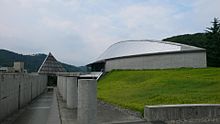Iwajuku
Coordinates: 36 ° 23 ′ 57.5 ″ N , 139 ° 17 ′ 8.6 ″ E
Iwajuku ( Japanese 岩 宿 遺跡 , Iwajuku iseki ) is an important archaeological site in Japan . Iwajuku located in Kasagake , Midori in Gunma Prefecture . The site is located in the southeast of the Akagi volcano on the right bank of the river Watarase , which breaks through the Ashino mountain range and divides into the hills Inariyama ( 稲 荷 山 ) and Kotohirayama ( 琴 平 山 ). It was declared a historic site in 1979.
overview
The amateur archaeologist Aizawa Tadahiro first discovered microliths in 1946 . Hoping to discover pottery, he searched the area now known as the Iwajuku B site and finally found other stone tools in a reddish cultural layer ( Kantō-Loam ). This new find prompted him to visit the archaeologists Sugihara Sōsuke and Chōsuke Serizawa at Meiji University to intensify the excavations at this point. The investigation confirmed the existence of two cultural layers from the Stone Age . The lower culture layer, the dark Kazuma clay layer, several meters thick, about 1.3 to 1.5 m deep and dated to about 25 to 30,000 percent, contained 29 stone tools made of slate, including two polished stone axes and cores made of slate. This was followed by the Kantō clay layer ( 関 東 ロ ー ム 層 ) from various weathered volcanic ashes , which had been deposited by eruptions from different volcanoes; including the Aira-Tn ash layer . At a depth of approx. 0.8 m there were 180 small tools such as arrowheads and knives made of obsidian , agate and andesite .
The finds brought evidence of the human presence in Japan before 10,000 BC. BC, i.e. before the Jōmon period , and thus represented the oldest evidence of human settlement in Japan.
In addition to the “Iwajuku Museum” ( 岩 宿 博物館 , Iwajuku Hakubutsukan ), which shows finds from the excavation, the city of Midori also maintains a web-based information system on regional natural heritage monuments, which can be searched using various, including image-based, indices.
Web links
- 岩 宿 遺跡 Iwajuku site. 日本 旧石器 学会(Japanese Palaeolithic Research Association),accessed January 19, 2014(Japanese).
- About the Iwajuku archeological site. Kiryu International Exchange Association, 2009, accessed January 19, 2014 .
Individual evidence
- ↑ 検 索 メ ニ ュ ー 選 択 . み ど り 市内 埋 蔵 文化 財 Web 公開 シ ス テ ム , 2011, accessed January 19, 2014 (Japanese).

